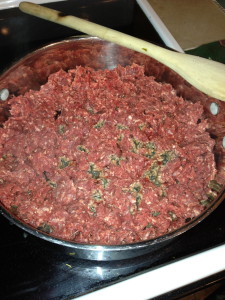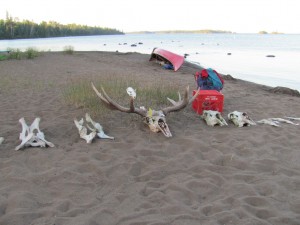While we don’t eat much red meat in our day to day lives, ground beef has become a staple in our backpacking food bags and we use it in many of our backpacking recipes. Filling, versatile and delicious, many of our favorite back country meals have ground beef in them, and it is amazingly simple to prepare! Dehydrating ground beef is easy to do if you follow a few basic rules.
Dehydrating Ground Beef: Step by Step
1. Start by finding the most lean ground beef you can find. Our local grocery sometimes stocks 93% lean ground sirloin, but I’ve also used 91% with good results. When dehydrating ground beef, the key is using lean beef because fatty meats don’t dehydrate or rehydrate well. I like to do large batches so that I can get prepare it at one time so I tend to make 4 pounds at once.
2. Saute the ground beef on the stove until cooked through. Break into small pieces as much as possible. This makes it easier to dehydrate ground beef evenly.

3. Once the beef is cooked, drain in a colander. Using your fingers, break up any larger clumps into smaller pieces. I also take the additional step of rinsing the meat with water to ensure all the extra fat has been removed.
4. Since I would wash any seasoning I had used off in the rinsing process, at this point I make sure to season the beef well. The process of de- and re- hydrating foods tends to remove some of the flavor so I am a tad bit heavy handed with the herbs and spices I sprinkle over the cooked beef. I choose the spices based on the planned recipe- basil, oregano and garlic for pasta sauces, cumin, chili powder and pepper for chili and so on. The spices I like to use at home are the same ones I like to eat on the trail so when dehydrating ground beef, season based on your personal taste.
5. Evenly spread the ground beef on liners and place on the dehydrator tray. I do about a pound of ground beef on each tray. I use a stacking Nesco Food Dehydrator which works great. Easy to use and super economical I am very pleased with my choice of dehydrators but there are many fancier models out there if you have the cash to spare. To line my trays I purchased several Fruit Roll Up Sheets
and Clean Screen Trays which are perfect for preventing sauces and small items from falling between the cracks on the trays. For dehydrating ground beef or any meat, I always set the temperature to the highest setting.

6. Now just leave it alone. I check it every eight hours or so but there is no exact science to it. It usually takes around 12-18 hours to dry four pounds of meat. Be aware that drying times vary depending on humidity, amount of moisture in the food you are preparing and the overall amount of food you are drying. Also, the more stacked trays you use, the longer it can take. Again, this is not an exact science. I sometimes get a batch going at night before I head to bed and don’t check it until after work the next day and have never had any problems.
7. Once it is fully dry, it will be dry and the consistency of gravel. I turn off the dehydrator and let it sit for an hour or so until it cools to room temperature to prevent any sweating before I package it. I package the ground beef into one pound (pre-dehydrated weight) sections by putting it in labeled quart size freezer bags. At this point they weigh around 4 ounces each. You won’t believe how light it feels!
Throughout the year I add to my stash of meals to take on the trail. I store my packages of dehydrated food in a chest freezer to ensure the longest shelf life possible.

Dehydrating Ground Beef: What to do at camp
When you are ready to use the ground beef in a meal, rehydrating it is super easy. Once we arrive at camp and about an hour before I will begin cooking, I add enough water to the freezer bag of meat to just cover it while I set up our tents and such. As the meat soaks up the water, I add a little more at a time until it starts to take on the texture of regular ground beef. I then place it in my cook pot over medium flame and continue to add water until it really does just look like regular cooked ground beef. Make sure you season well because like I said before, the de- and re- hydrating process does remove a lot of flavor. You can now use ground beef in any backpacking recipe you like. We love making spaghetti bolognese, chili, tacos and so on.
I have a few favorite back country camping cookbooks I will share with you. While I don’t tend to follow any recipe exactly, each of these books have given me ideas and inspiration for good trail meals.
Fork in the Trail: Mouthwatering Meals and Tempting Treats for the Backcountry– by Laurie Ann March
Trail Food: Drying and Cooking Food for Backpacking and Paddling– by Alan Kesselheim
Mary Bell’s Complete Dehydrator Cookbook– by Mary Bell
Lipsmackin’ Backpackin’– by Christine and Tim Conners
The Ultimate Dehydrator Cookbook – by Tammy Gangloff
Recipes for Adventure: Healthy, Hearty and Homemade Backpacking Recipes by Glen McAllister
Cooking delicious food that is nutritious and filling is an important part of successful backcountry treks. For more ideas, check out some of my other favorite recipes on my Backcountry Cooking page. As always, if you have any questions about backcountry meal prep or backpacking recipes, please let me know and I’ll do my best to answer them.
Happy travels!
If you decide to make a purchase through my links, Amazon will pay me a small commission for it. This doesn’t cost you anything additional. These commissions help to keep the rest of my content free, so thank you for your support!




What a great way to save ground beef
is it necessary to cook the meat first though, i wonder?
I think so, mainly because cooking it first releases much of the fat. I’ve never tried to not cook it first though, so am not entirely sure.
Do you ever package an entire meals together or prep all parts separately and pack them in together?
It really depends on the dish. Things like potato or lentil soup dehydrate well together. Things with various textures work better with separating them in my opinion.
i take it that you can put it jars, is there anything else I would need to do with this ? Pressure cooker / water bath ? Thanks in advance !!
I just put the final product in zip lock bags. With all the water out of the beef, bacteria doesn’t grow. So easy!
Great article! Do you have to store it in the freezer or is that personal choice?
I store it in freezer, but it can be stored in any cool dry place.
awesome! what kind of shelf life are we looking at though? 🙂 t.i.a
I’m not sure exactly how long it would last. I’ve stored dehydrated ground beef in the freezer for over a year and it’s been fine. As long as all the moisture has been removed, it will last for a very long time. Hope that helps!
Thanks for the step by step instructions. We’re planning a week long mountain bike trip and I’m looking forward to good (but light) eats!
Have fun! Sounds amazing!
Can you use it as part of the mix in a meal in a jar recipe? I’d like to know. Thanks!
I don’t see why not. I don’t keep it stored with the other ingredients because we have one vegetarian in our family so I add any meat separately but think it would do fine this way.
I had no idea you could do this! Thanks so much for sharing at last week’s All My Bloggy Friends! I can’t wait to see what you share this week!
I never knew you could do that!
It is amazing how many things that can be dehydrated. Makes having tasty backpacking meals much easier!